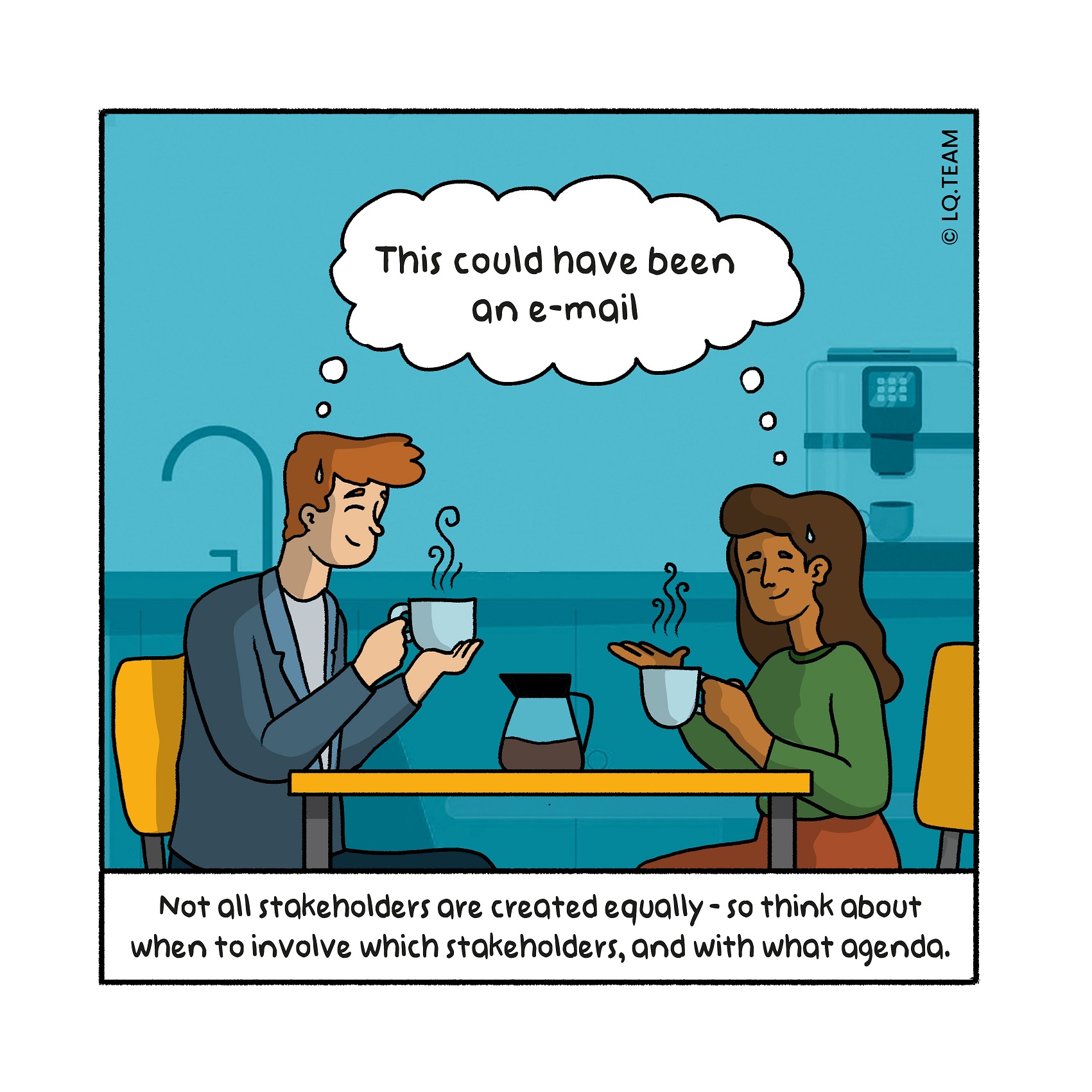
Nut to crack: When to involve which stakeholders, and with what agenda
In today’s organisations, people often have distinct roles and are part of multi- ple teams. Decisions are made within the proper hierarchal setup and through informal communication chains. To be able to manage an organisational trans- formation in this force field, it is important to know who your stakeholders are. So, who are they? When and how do you involve them? And what information do you share with whom?
Nutcracker: The 80/20 rule
There may be dozens of stakeholders even for a simple organisational change. This number will grow exponentially with the increased complexity and scale of the transformation. The 80/20 rule will help you manage your and your teams’ capacity and time in involving stakeholders: becoming aware that if you reach the critical 20 per cent of stakeholders, you can influence 80 per cent of your outcomes will result in smarter choices and interactions. That doesn’t mean you shouldn’t reach the other stakeholders; it just means a different level of interaction. Support tool I, the stakeholder mapping ana- lysis, facilitates making those smart choices. Support tool II – the “Do, Feel, Know, Say” analysis – can help determine which conversations to have with whom and on what subject. The real-life example illustrates how to mobilise an important stakeholder group: the informal leaders.
Support tool I: Differentiated stakeholder management
When reaching out to your stakeholders, it helps to differentiate between stakeholders who need comprehensive managing because of their sizable stake and influence, and stakeholders who require minimal effort in keeping them in the loop. Draw up a table. Place the different stakeholders in four groups, based on their level of interest on the one hand and level of influence on the other hand. Low interest, low influence means manage with minimum effort. Low interest, high influence means keep a close eye. High interest, low influence means match basic needs. High interest, high influence means manage closely. Next, plot key names of individuals or groups in each of the four categories, their attitude regarding the change, what you want to discuss, how you want to have the discussion and who and when should deliver the message per stakeholder or group of stakeholders. This way, stakeholder management becomes a proactively
Support tool II: Do – feel – know – say
Thinking about the four elements “do, feel, know, say” helps you decide with whom to have which conversation. For example, let’s say you want the direc- tor of a business unit to actively support the new circular business model (do), even though you know he is not really into this “green business” yet. How do you mobilise this person? How does he have to feel to speak positively about this on a day-to-day basis? It could mean that this person must not only feel inspired but also confident and responsible before he will comment (feel). That may require him to better understand the advantages for himself and the business than he does now, and he may need to become conscious of the role model he is expected to be (know). Once you have formed a clear picture of what is required for this person, you can decide who needs to have a conversation (say) with him and what should be on the agenda. In this case, it could be a meeting for this director with his peers from the industry to exchange ideas on their approach to circularity, which could also give him the nudge he needs to start experimenting in this field, and a conversation with his boss in which he is being asked to take accountability for proactively putting this subject on the map and taking responsibility as a role model.
Real-life example: Find the informal leaders
A director is on the verge of integrating two banks. To merge the banks successfully, she wants to know who the most critical informal leaders of the organisation are. How does she find and “utilise” them?
An organisation chart only tells you part of the story about who has the real influence. She therefore analyses the informal social relationship network by asking the employees a few simple questions. Her questions are about transactional and emotional relation ships, like: “Who do you go to for workrelated questions?”, “Who do you ask to brain storm about a challenge you are facing?” or “Who do you go to for advice before taking an important decision?”. She can use supporting software to create an anonymous visual showing where the informal leaders are. She concludes that the innovation department hardly ever gets consulted and that there is a middle management layer in one of the business units, which contains numerous informal leaders who also influence leaders of other business units. Based on this information, she decides which people to pull into the transformation as ambassadors. This helps her execute the integration faster and smoother.
Tip for change leader
By partnering up with a colleague who is regarded as an informal leader in a part of the organisation to which you don’t have easy access, you can boost your impact naturally. Should you choose to partner with a much younger buddy, it can effectively bridge the gap between the different age groups within the organisation.
Tip for change enabler
By periodically assessing stakeholders’ level of commitment, you can identify which conversations are needed at which times. Challenge 45 explains how to measure indi vidual commitment levels.
Kernel: Have the right conversation at the right time
In a worst-case scenario, stakeholder management involves ticking boxes in a matrix with no actual influence or impact. Make sure stakeholder manage- ment is about effective two-way conversations with the right people at the right time, through which individuals become mobilised.
